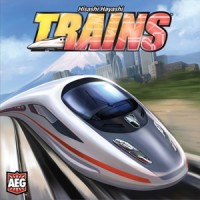
Trains
Overview
In Trains, players act as burgeoning industrial planners seeking out the most valuable routes for their high-speed railways and stations. Through the course of the game players will not only lay rails over several different terrains and try to reach the most valuable destination cities, but they will need to pepper their tracks with revenue generators – both industrial buildings (such as a Control Room) and consumer establishments (Amusement Parks, Apartment Buildings, etc.) You’ll also have a chance to upgrade your fleet of trains to specialize: do you want to move commuters? Freight? Mail? It’s your enterprise – make the most of it!
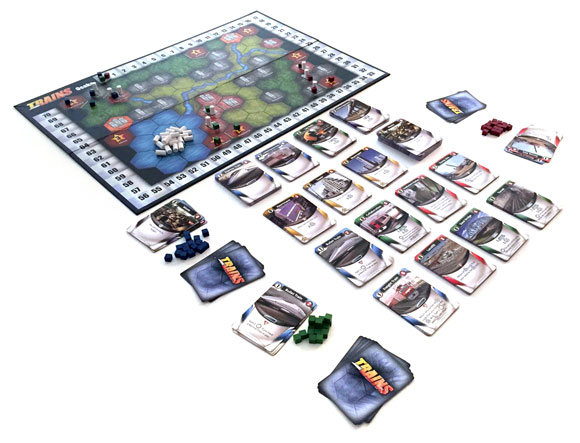
Set Up
While Trains is partly a board game, set-up is closer to its deck-builder ancestry. There are 16 piles of cards to arrange in a common area; 8 of these are static from game to game, while the other 8 are determined randomly through the use of an included randomizer deck.
Next starting decks must be created for each player. There are 3 types of cards in your base deck: Normal Train, only useful as the game’s monetary unit; Lay Rails, your means to expand into adjacent areas; and Station Expansion, necessary to build the stations that will score victory points at the end of the game. Additional Lay Rails and Station Expansion cards are available for purchase during the game, but your starting Normal Trains are the only ones you’ll get (more powerful train cars are purchased during the game).
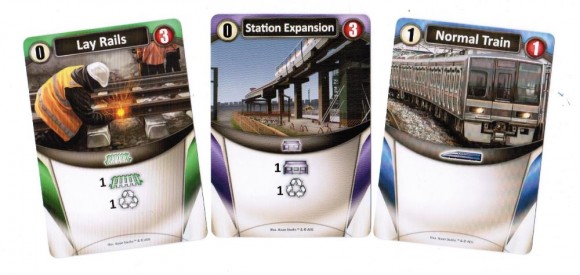
Each player claims 20 wooden cubes in their player color representing their train line and one scoring cube, which starts on the 0 spot of the victory point tracker that encircles the board. In turn order each player places a starting track on the board – most of the board is fair play, but a few special spots (Remote Locations) are off-limits for initial placement. Finally, 30 neutral-colored wooden Station markers are placed near the board for use by all players.
Gameplay
In typical deck-builder fashion you begin with a hand of five cards, expend those cards, draw a fresh five and play continues clockwise around the table. What makes Trains starkly different from other deck-builders is what you do when you use your cards. Rather than attacking monsters or erecting a smithy, you will be laying train tracks and building stations – actual wooden cubes on an actual board! No more laying cards in front of you and pretending they represent a castle. Welcome to the future!
The cards you play are used for any action they list (such as expanding your train line, building a station or scoring victory points) as well as any purchasing ability they give you. Many cards have both a purchasing figure and an action or effect – these cards may be used for both purposes when played. Any unused cards at the end of your turn are discarded, so it behooves you to use as many cards as you can during your turn.
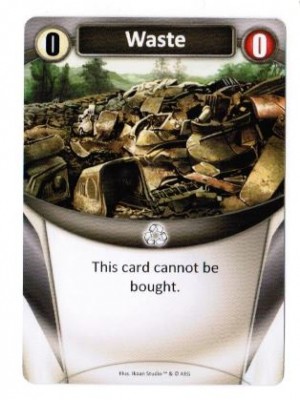
When you take any action that builds, Waste will be generated. Waste is a useless card that clogs up your deck and becomes an increasing nuisance as the game goes on. There are two means to eliminate Waste from your deck: you can skip an entire turn to eliminate any Waste in your hand or you can purchase cards that allow you to eliminate Waste cards without skipping your turn (these cards may or may not be available depending on the Randomizer cards drawn during set-up). Thematically, it’s refreshing that a game recognizes the environmental impact of unchecked industrialization… and the work necessary to clean up afterward!
The expense of building is determined by the location: empty fields can be built on for free, while building on a mountain that already contains another player’s rails could cost enough to prohibit you from purchasing a new card on that turn (and force you to take an additional Waste). Some of the game’s juiciest decisions come from having a hand that allows expansion but trying to get the most out of your resources.
Play continues until one of three game-ending conditions is met:
- Any player places their final rail cube
- Any player places the final Station (from the communal pile all players draw from)
- Four card piles in the common area (excluding Waste) are empty
At any such event, play stops and victory points are totaled.
Components
The game board is 2-sided, with one representing Osaka and the other Tokyo. Having two maps to choose from adds some variability to the game, but they’re not different enough to change the way you’ll play.
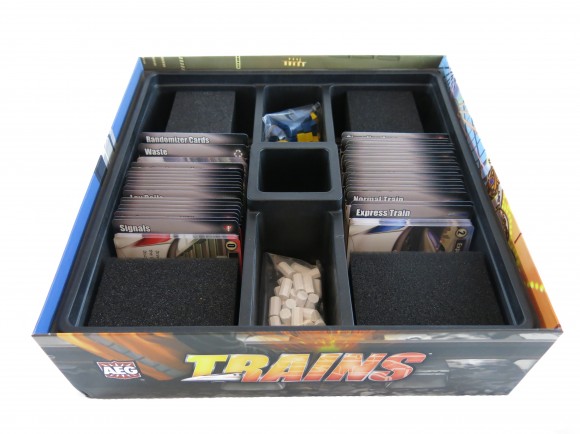
There are 114 small wooden bits: 21 cubes in each of four player colors and 30 Station markers in a neutral white.
While there is nothing wrong with the board or the wood parts, the real component quality of Trains lies in the cards. They are of a thick and sturdy stock with nice artwork, and they’re very easy to read. They contain a logical symbol-based system which keeps most of the cards from appearing cluttered, and the graphic design draws the eye to the 3 parts of the card relevant to gameplay: cost (money necessary to purchase the card), value (money the card gives you when played) and card type/effect (what action you may take on the board).
There are 500 game cards in total (this doesn’t include randomizer cards). These 500 cards come in 39 unique flavors; 200 of them belong to the 8 “always available” cards that are involved in every game and the Normal Train cards included in players starting hands. The remaining 300 are divided into 30 unique cards which are subject to the randomizer. You can play 3 games of Trains without using a randomized card twice, and still have 6 cards you’ve never used! That’s much more variability than deck-builders commonly include.
Learning Curve
While prior experience with deck-builders will grease the wheels, Trains is extremely easy to pick up. The rulebook is nicely arranged and easily understood in one reading. The symbol-based approach to most cards is a welcomed diversion in a genre that frequently includes paragraphs on its cards. This is a game you can self-teach and get right on the first play… and do so in a reasonable amount of time.
Who would enjoy this game?
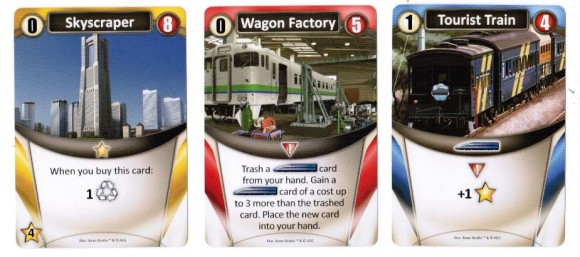
Final Thoughts
In just its base set Trains manages to deliver a level of replayability that takes other deck-builders a few expansions to attain. It’s pretty unusual for the base box of a deck-builder to allow two games without a repeated card in play – Trains gives you nearly four! And each of the 30 cards subject to randomization is decidedly different. This gives every game a unique feel. Now if only they could do something about the limited maps…
Well, AEG has! Trains Map Pack 1 is a 2-sided expansion board with maps of Germany and Northeastern US, and these maps are much different from the Osaka and Tokyo maps included with the game. They contain small landlocked bodies of water that provide un-crossable barriers, and will accomplish what the included boards failed to – they’ll make you adjust your gameplay. Note that the Japan and Osaka boards contain un-crossable bodies of water, but they’re clumped together in a corner of the board and serve only to make space a little more precious.
AEG has also released a stand-alone expansion: Rising Sun. This includes 3 new maps, 2 of which are designed for 2-player games. These will solve another short-coming of the base game: in 2-player games on the Osaka and Tokyo maps, it’s easily possible to play an entire game without running into your opponent’s rails at all. While there is no way to stop another player’s expansion regardless of how crowded the board becomes, tight quarters will at least force players to weigh the value of their money a little more deliberately (you’ll need more of it if you want to build in the same location as an opponent’s rails).
Finally, there are 4 free Print-and-Play maps available from AEG’s website for boards given away at the 2013 and 2014 GenCon events. These contain additional 2-player maps as well as enhanced rules for 2-player games (like making smaller decks of cards to start the game and having static starting rail locations).
If you’re a fan of deck-builders and Trains isn’t in your collection, go get it already! While the game mechanic of building your deck will be instantly recognizable, its use here is too novel to miss out on. And for anybody who hasn’t played a deck-builder or may be on the fence about them, Trains is a great way to get your feet wet. Its simplified ruleset makes Trains approachable, but it contains the same deep gameplay as the heaviest of the genre.
User Reviews (7)
Add a Review for "Trains"
You must be logged in to add a review.



“What if Dominion and Ticket to Ride had a baby?” That was the opinion of one of my friends to whom I taught the game during GenCon.
Trains is AEG’s English-language release of the Japanese game of the same name which debuted at Essen 2012. The core of the game is a deckbuilder: you start with a tiny deck of basic Normal Train cards, some Lay Rails cards, and a Station Expansion. You use the money produced by your cards to purchase more cards from a common pool of 15 piles, acquiring them to be shuffled into your deck. You can also use your money in conjunction with your Lay Rails cards to put railway track (in the form of colored cube markers) onto different terrain types on a hex board map (in the base game, maps of either Tokyo or Osaka).
Deck management and board management go hand-in-hand. You can build into cities, which you can develop with Station Expansion cards to increase your victory point total at the end of the game; into remote locations which are worth straight VP; and across the board to interfere with or mooch off of your opponents’ builds.
The piles of cards to be purchased include advanced Trains, additional Lay Rails (and better versions), additional Station Expansions, and Action cards, as well as Buildings which are worth straight VP at the end of the game. Cards which involve construction and development (rails, stations, buildings) also put Waste cards into your deck. These are chaff cards which clog up your deck. They are a central part of Trains’ game mechanics: you can hold your Waste, manage it with other bought cards, or skip a turn to purge all Waste from your hand back to the Waste deck. Deciding the best strategy from turn to turn can dictate what you are able to accomplish with your deck. Each turn allows you to use any or all of your cards in hand to add to your deck or work on the board, as the cards permit.
Play lasts until a player has laid their last rail token, until any player has played the last communal station token, or until four of the fifteen non-Waste card piles have been depleted. This is usually about 45 minutes for a four player game. Replayability is high, since eight of the sixteen card piles are fixed and the other eight come from a pool of thirty different cards. Additionally, multiple maps can change a player’s build strategy from game to game.
The basic map is high quality and dual-sided. Card stock is sturdy and unlikely to break down easily. The tokens used for rails and stations — colored cubes and colorless hexagonal cylinders, respectively — are not terribly representative, but they are simple and easily distinguishable. The most common point of confusion among new players was the use of the universal recycling symbol (arrows in a triangle) to represent taking a Waste card, but it was not a barrier to play.
Pros:
High production values
Substantial replayability
Easy to teach to new players
Reasonable setup and cleanup time
Short (45 min) play time
Cons:
Some dissociation with components
Lack of ways to trash cards from deck (deck thinning)
Will ruin you, a bit, for other deckbuilding games
Trains’ box art tells us two things. One, it’s dull. Two, it’s straight to the point. The former is false. The latter is true. This is most certainly a game about trains. “But I already have ‘Ticket To Ride!’ I don’t need ANOTHER train game.” I hear a million of you cry. Well Trains captures all the joys of cross-country rail domination in a more tactical package.
‘Trains’ is the sort of game that begins training montages glaring at pictures of Dominion stuck to its mirror. A deckbuilder at heart, it gives players the opportunity to build a network of delays through a hand of trains and rails. Picking up 5 cards from their deck, a player can gander at their resources and grow their empire across Tokyo (or Osaka…if the bird’s eye view of Tokyo gets someone so angry they flip the board over to the game’s alternate map). Using trains as currency and the right cards at the right time, they can lay rails across the map or spend those trains on buying even swishier trains worth even more currency. A market exists on the side of the board, selling off sexier trains, more opportunities to lay rails or even abilities that instantly gain you victory points. Should you buy up anything that gives you points, however, you’re likely to gain cards that are literally rubbish.
Every time you pull a move that will climb you up the Victory Point ladder, you get a ‘Waste’ card added to your deck. They do nothing but stink up your deck and potentially clog up your hand, providing no aid to your networking antics. They halt those becoming heavily empowered with glossy cards. They are also Trains’ sneaky little way of making you miss a turn and still feel like a professional at rail laying. Should you skip a turn, you can banish any waste cards in your hand back into the waste deck, cleansing your deck until you clog it up again with more waste. Even with the inevitability that you’re soon going to be gargling in litter again soon, you still feel good for getting it off your chest for a few seconds.
Trains is not a game of mind-bending strategy, as any deck builder’s mechanics will rely on luck in some way or another. With just the listed mechanics in place, Trains would simply be a game of luck with a board gimmick tacked on top. However, each game not only holds the regular market of train and rails resources, but a market of eight randomly generated components. 30 resources lay in wait in the box, and at random, eight are pulled out to form a unique market each time you play. These cards are what make the game such a joy to play every time you bring it out. They give players the chance to personalise their deck with viable tactics in the future that may shower them with well-played combos or smite them with poorly planned decks. Weighing up the board with the chances of getting the right card at the right time is what presents dilemmas in this game. The stress of hoping that you picked a combination of cards that compliment each other adds with the stress combined with hoping that the others players aren’t jerks that will cut you off or steal your well laid plans for points. It has meant that my fiancé and I have played it on a daily basis since buying it last week, and there are still cards that haven’t cropped up.
The cards, for what they are, look great. It’s hard to make a set of signals seem alluring through pictures, but it’s a testament that none of this art can be considered ‘dull’. Clear instructions and icons on the cards mean that there’s very little confusion during play and it’s easy for newcomers to pick up and get to grips with the systems. Boardwise…well…I mean, it does the job. Hexagonal plains present a frank but practical view of gameplay (even though the ‘Mountain’ areas clearly look more like forests) and the wooden cubes players place to establish dominance convey…railism…in some aspect. Perhaps I’ve been spoiled by TTR, but some wooden train markers would liven up things in some way.
It’s clear that I have nothing but respect for Trains, so the main question here is this. Should you buy this if you’re already a dominion owner? If you are content with watching your deck slowly build up with tasty resources and that very satisfaction is all you need, the board of Trains will seem like an unnecessary gimmick, and you’ll especially scoff when some cards mimic certain actions from that game. However, if you’re looking for that extra little layer of strategy to your card building proceedings and want a new way to board your card stacking accomplishments, playing Trains is undoubtedly the best way to satisfy your needs.
Overview
Trains is yet another strong entry in the “deckbuilding” genre of games started by the game Dominion. In fact, many say that a lot of mechanics are a direct rip-off of Dominion. Personally, I don’t care, because the theme of Dominion never appealed to me. However, there are some twists to this game that greatly improve upon standard deckbuilder fare.
The goal of the game is to build up your railway empire by connecting to cities and building stations for points.
Pros
Strong replay value
Box is ready for expansions
Good theme
Really easy to learn
Has a map!
Cons
Could use more maps (comes with 2)
Needs a way to better control deck cyclers.
Gameplay
Players start out with the same basic deck of 10 cards and a common pool of cards available for sale by all. The common of pool of cards have a set of standard cards that are always in the game and another set of cards that are randomly drawn at setup. This greatly adds to the replay value of the game, because the set of cards that are drawn at setup time can drastically change the way you approach the game.
Players begin by picking their starting city by placing a token in it. Then start their turn by drawing 5 cards from their deck. Based on their hand, they can then choose to purchase more cards with their “train” cards, build a station in a city in their railroad network with a “station” card, put down more rails with “lay rails” cards, or perform certain actions with “action” cards. A player can perform as many actions as they can afford to do. Once they complete their turn, they discard their cards and put new cards on the discard pile, then draw up another five cards. Play proceeds to the next player. Players continue to do this until either the station tokens run out, a player runs out of railway tokens, or four sets of cards from the common pool have been depleted.
Players score points by building stations in cities, connecting their rails to special “point cities” on the map, or collecting certain cards that score you points (some of those clog up your hand). Whoever has the most points at the end of the game wins.
Cool things
What is really neat about Trains, is that every time you expand on the board(rails or stations or extra for building on existing opponent territory), you always collect “waste” cards. This makes such a deliciously thematic environmental connection, because you’re going to generate a lot of waste making railroads. These cards serve no purpose but to clog up an efficient deck you’ve been building. This really turns the game on it’s head in a special way, because you have to determine how you are going to manage the waste in your deck especially if there are no cards available to eliminate waste from you deck.
Add to it the fact that victory point cards also clog up your hand. So you really have to balance out how early in the game you start building out your network and take on waste cards versus when to start buying victory point cards before the game ends. Both of these elements can really diminish the playability of your hand, so you really need to consider the cost of your actions.
One Caveat
So far, the only problem, I’ve seen is counteracting people who solely focus on cycling through their deck and hardly build up their railroad network. This strategy is based on getting lots of money, to then start buying up victory point cards. This is really killer with “Tourist Train” in the game, because every time it is played, it scores a point. You can see how cycling through your deck over and over again with Tourist Train can really add up. The only way I know to counteract that is everyone start buying up “Tourist Train” or don’t allow this card in the game when it’s drawn at setup. Also, you’ll be forced to start buying up victory point cards earlier, if someone is intent on cycling through their deck.
Conclusion
I really really like Trains, and so do my two older kids! My son who’s big into “action” games like Sentinels of the Multiverse, thought Trains was going to be boring. However, after playing it, it quickly became his favorite game! I enjoy how streamlined the mechanics are and how fast turns can go for each player. I find the “waste card” mechanic absolutely brilliant. I really enjoy the “train” theme and how you build up your railroad empire. At the end of the game, you can actually see that you accomplished something by looking over your network.
This game is really easy to teach. My 9 and 11 year old picked up on it in no time. So, I think this game easily qualifies for “Family Gamer”. Besides, the theme is pretty cool.
“Casual Gamers” might find this enjoyable if they’re willing to learn a few rules, but it’s really not that hard to pick up.
This game has subtle enough strategies that I think it would appeal to “Strategy Gamers” and “Avid Gamers”. With the another expansion having been announced, I’m sure this would make it even more appealing.
“Power Gamers” may be more interested in Dominion with it’s enormous amounts of expansions instead of Trains until more is available.
Overall, if you’re fan of deckbuilders, I recommend it. If you’ve thought about Dominion, but weren’t really intrigued by it’s dry theme, you should really give Trains a shot.
I like starting off with tipping over sacred cows – and don’t get me wrong, I enjoy Dominion – but I’d rather play Trains over it any day. Is this because of my Dominion disillusionment that came from my friend winning 75% of all games he played by only buying money and vps? Perhaps. But Trains certainly doesn’t have this issue – because victory points come multiple different ways. You can play it likes it’s Dominion and just buy victory point cards – but you will lose – because your opponents will be snapping up distant locations and building stations on the map. You’ll need to get your rails on the map if you expect to win – which brings us to the second interesting thing Trains does –
Unlike Dominion’s approach that has you sitting on a runaway engine of victory point generation, Trains lets you build an engine, then bogs it down – as everything you do on the boards throws waste cards into your deck. Managing waste becomes just as important as buying cash, since it’s very easy to decrease the value of your deck beyond even it’s starting value. The game has an interesting balancing component, with you trying to get to victory point locations on the board before your opponents do, so you can get in on the cheap while also trying to keep you deck engine running at least semi efficiently. Tempo can also be important to control – since some players may not opt for the quick start and try to get a decent engine going first before hitting the board. Then it becomes a race – with the players who got the early victory point lead trying to end the game before the heavy engine can overtake them.
Overall – just a great game. Best use of deck building mechanic in a game yet.
When it comes to deckbuilding games, many can point towards Dominion as one of the classics up towards Marvel Legendary. Trains, while having such a simple title, is not just a simple deckbuilding game. In fact, the true power behind the game is the fact that it comes with a board along with 500 cards and a few components. Let me explain.
Trains is a deckbuilding game where, much like any other game, you buy cards to build a deck, allowing you to buy better cards and even those wonderful victory point cards.
But wait! There’s a catch this time around.
The board itself won me over because it’s another way to not only gain victory points but to feel like your laying down rails on the board. You now have the chance to not only expand into cities between the double sided board (Osaka or Tokyo) but to other small cities to give you the most points.
While you still have you main currency (reflected as trains), you now have the Lay Rails and the Station Expansion cards, allowing you to lay the rails towards cities and build stations in those cities to net you the most points. However, a factor in that whatever you do, you gain a Waste card. From laying down rails, expanding into rivers and mountains, to building stations and even putting down a rail with another person, you gain a Waste card, giving you nothing but an extra card of nothing.
The fact that you can use the board with the cards you have to gain victory points is a much needed breath of fresh air when it comes to deckbuilding games. Trains has the chance to be a great game with everyone if expansions start happening down the road and I fell in love with the game. It’s not the cards (they do look lovely) that won me over, it’s the fact that you have two ways to win that make this game that much enjoyable.
I was so excited to buy this game after all of the good reviews! When my group finally got around to playing it, it ended in crashed hopes.
This is not a good game to play after you have become accustomed to (and addicted to) games that require attention to multiple areas – think Agricola.
The most difficult part is deciding which side of the board to play. Next difficult is selecting your starting point. That’s it. You just lay track from that point. There is no need to adjust strategy because someone else got to your destination before you. There is no interaction with other players.
It would have been nice to use wooden trains for the tokens instead of wooden cubes.
I played this for the first time on TableTopDay 2014. We instantly liked it and have been thinking of getting our own copy. It is a deckbuilder and, yes, it is very similar to Dominion. In fact, throughout the game the players kept making comparisons between Trains cards and Dominion cards. The cards in Trains don’t ever get as complex as some of the cards from Dominion expansions, but they still make for a fun, fast paced deckbuilder. (Also, we didn’t really mind the similarities to Dominion since we love that game so much.)
Why I really liked this game is the fact that it adds a board element. I do love many card games (including Dominion) but there is something to be said for placing pieces on a board and creating a world there. (I am also a sucker for any board that is a map and this one is a great stylized version of Tokyo and its surroundings on one side and Osaka on the flip-side.)
My only real downside to this game is the components. I also own Smash Up and AEG has included the same slick-style cards here which aren’t really my preference. Also, when laying down your ‘train routes’ on the board you are just using tiny colored wooden cubes. This game would benefit greatly from some Ticket to Ride style train pieces. In fact, I was thinking if I get my own copy that I’d order some extra train pieces to substitute for the cubes.
The game is not gonna break your brain with deep strategy, but the gameplay is really quick and easy to learn. Everyone had fun playing. And, the most important part, when it was over we wanted to try it again!